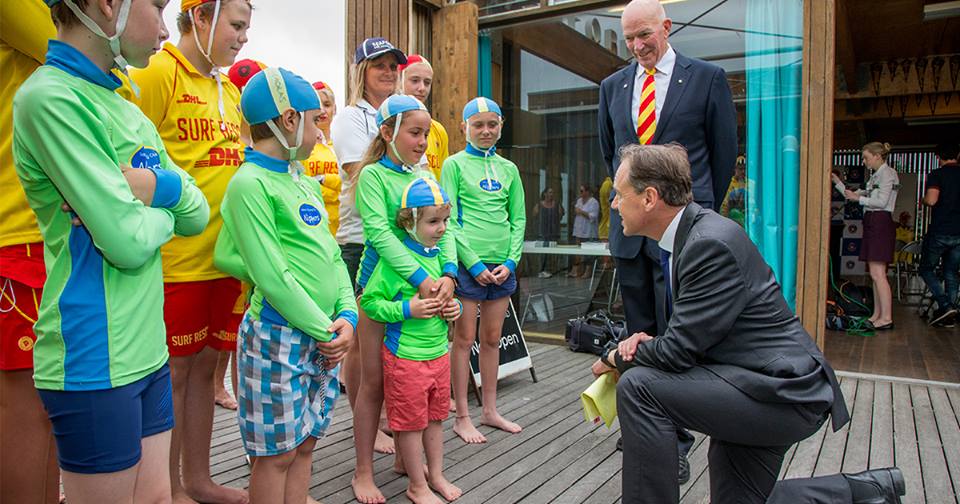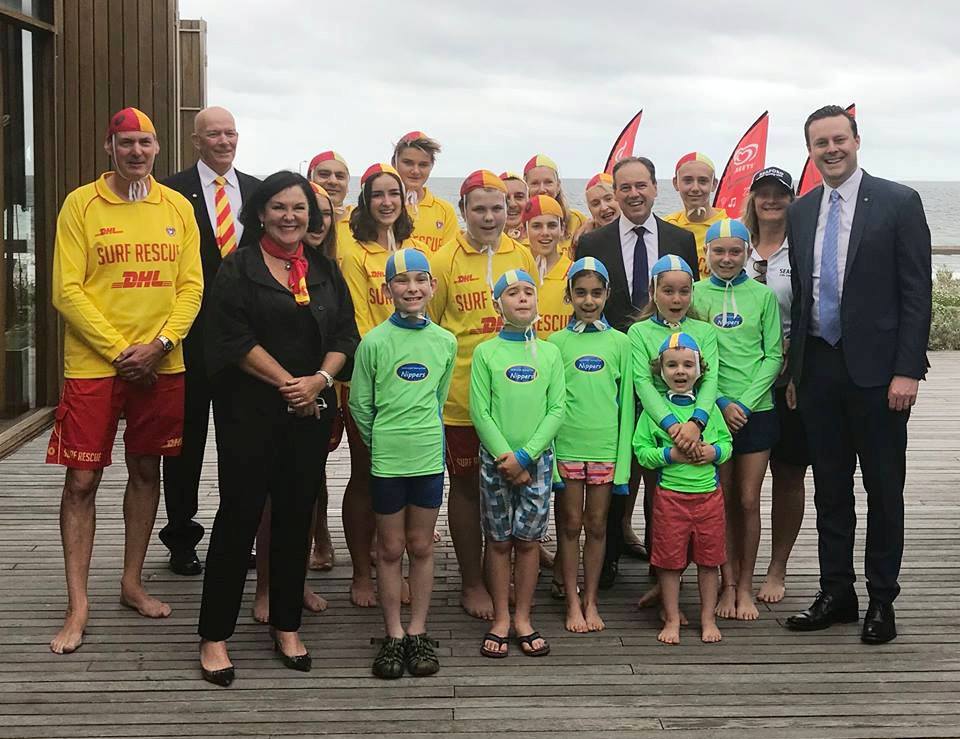December 17, 2017 - January 13, 2018: Issue 342
Surf Life Saving Australia’s 2017 National Coastal Safety Report

The Hon. Greg Hunt MP and Graham Ford AM speak to some surf lifesavers and nippers from Seaford LSC at the 2017 National Coastal Safety Report launch. Photo courtesy SLSA
Surf Life Saving Australia releases 2016-17 drowning data
14 December 2017Surf Life Saving Australia (SLSA) today released the National Coastal Safety Report 2017 revealing 116 coastal drowning deaths occurred in the past year.
The report was launched at Seaford Life Saving Club by the Honorable Greg Hunt, Minister for Health and Sport and highlights many significant factors around coastal drowning deaths.
With recent tragic events involving children and teenagers in New South Wales (missing 11 year old, Lighthouse beach) and South Australia (drowning death of a 15 year old girl from India at Glenelg beach), SLSA wants all to be water safety conscious as we lead into the Christmas holiday period.
While the 116 coastal drowning deaths is a nine per cent reduction on the previous year, it is the third highest number of fatalities recorded in the past 13 years.
Of these coastal drowning deaths, men are over-represented at 83 percent of the recorded fatalities.
Swimming/wading is the most common activity preceding a drowning death (28%, n=32), and with a corresponding increase in swimming/wading participation at coastal locations by (4% to 10.1 million in 2017).
Graham Ford AM, President of Surf Life Saving Australia said: “Today we heard about 116 coastal drowning deaths due to the unpredictability of our oceans. These aren’t just numbers, it’s 116 lives, it’s someone’s mother, father, brother, sister, child or friend who didn’t return home from the beach.”
“These findings show that there is still work to be done in driving a national agenda on water safety education, and in promoting safe practises such as swimming between the red and yellow flags and wearing a life jacket. With government, community, business and water safety agencies working together, we can make a difference,” he said.
“We are imploring all Australians to take extra care when undertaking water related activities on our coastlines.”
This last year four states – West Australia (26), South Australia (10), Queensland (22) and Tasmania (8) – experienced an increase in total recorded drowning deaths on the previous year. Reductions occurred in both Victoria (15) and New South Wales (32) while the Northern Territory (3) reported parity on the previous year’s data.
“The need for increased education and behavioural programs for all beachgoers remains of critical importance in light of the reports findings,” said Minister Hunt.
“We are fully committed to working with Surf Life Saving Australia to achieve their vision of zero preventable deaths in Australian waters. A day at the beach or on the water should be a happy memory and not one of tragedy so it is vital to heed the advice and warnings issued by Surf Life Saving.”
The National Coastal Safety Report 2017 highlights additional key findings including:
• Although 43 per cent of coastal drowning deaths occurred at beaches, 26 per cent occurred offshore.
• 40 per cent of coastal drowning deaths occurred at least 5km from a Surf Life Saving Club (SLSC).
• 59 per cent of coastal drowning deaths occurred during other activities including boating and PWC (personal water craft – jet skis); snorkelling; rock fishing; scuba diving; and watercraft.
• Only 39 per cent of people report they usually swim at patrolled beaches during patrol hours.
• Six in ten people who say they can identify a rip current correctly, get it wrong.
• One in five Australians say they have a lifejacket at home, however only 42 per cent of boaters and 13 per cent of rock fishers say they always wear a lifejacket when participating in those activities.
Surf Life Saving Australia is asking the public to take precautions when recreating in coastal areas this summer:
• Where possible swim at a patrolled beach between the red and yellow flags
• Obey the safety signs at the beach
• Learn how to identify a rip current and look for rip currents before deciding where to swim
• If you’re not sure, ask a lifesaver about the beach conditions
• Wear a lifejacket while boating, rock fishing or paddling
• Don’t go into or on the ocean during severe weather warnings
• Take personal responsibility, think twice and assess your safety and ability before entering the water
• Supervise children at all times in and around water.
Last year Surf Life Saving services were involved in more than 10,000 rescues and nearly 4 million preventative actions. That equates to 30 rescues a day and 900 preventative actions each hour.
Surf Life Saving Australia remains committed to its vision of zero preventable deaths. Awareness campaigns, education programs, joint Federal Government initiatives and community-driven activities are crucial Surf Life Saving initiatives for the reduction of coastal drowning deaths.
To read the full report please visit https://sls.com.au/publications/
National Coastal Safety Report is an important reminder for everyone to be alert and cautious in the water this summer
14 December 2017: Joint Media Release - The Hon. Greg Hunt MP, Minister for Health, Minister for Sport and Chris Crewther MP, Federal Member for DunkleyThe Australian Government has launched Surf Life Saving Australia’s 2017 National Coastal Safety Report – which found that 116 people died from drowning around the Australian coastline in 2016-17.
While this was down from the previous year, it was 10.5 per cent higher than 2014-15.
It’s a timely reminder for swimmers of all abilities to still be cautious when undertaking any water activities this summer.
One death is too many and the number of Australians and visitors who die from drowning each year is simply not acceptable.
Only 28 per cent of people who drowned were swimming or wading at the beach. This figure could have been much higher, as life savers rescued almost 11,000 people at beaches with flags and patrols last year.
Other activities in the surf or sea claimed the most lives – boating, jet skiing, snorkelling, rock fishing, and scuba diving, which cannot be supervised by lifesavers.
People need to be more diligent with simple safety precautions such as swimming at a patrolled beach between the red and yellow flags, and wearing a lifejacket while boating, rock fishing or paddling.
This applies to men in particular, who represented 83 per cent of people who drowned in coastal waters nationally and 90 per cent of those who drowned were in New South Wales.
This year, the Turnbull Government will provide more than $15 million for ongoing water safety activities by organisations including Surf Life Saving Australia, Royal Life Saving Society Australia, AUSTSWIM and Laurie Lawrence Swimming Enterprises.
These activities include awareness raising and education, policy advice, surf lifesaving activities, surf patrols, swimming lessons, swim teachers’ training and education and new rescue technologies.
Have a swim at the beach or pool is a great Aussie tradition but we need to take care.
That’s why earlier this year, I asked for a review of the Australian Water Safety Sector to see if we could do more to keep people safe in the water.
I have now received that review, and it’s confirmed that the overall direction of the Australian Water Safety Strategy is sound.
The review recommended multiyear agreements and that we consolidate the programs, reducing the administrative burden. We support the recommendations and will be now looking to implement them.
If you are heading to the water this summer, for swimming, fishing or any other activity, please know your own ability. Listen to your local surf life saver and heed warnings, take care and be safe.
Read the Surf Life Saving Australia’s 2017 National Coastal Safety Report at:
https://issuu.com/surflifesavingaustralia/docs/ncsr-2017_lr_3298b910d49b62
